
ACT
National Gallery of Australia
The Conservation department at the National Gallery of Australia has been persevering through the several natural disasters that have hit the ACT, including bushfire smoke and hail. Staff have devoted a lot of time to assessing the risk of smoke damage and undertaking research and analysis on the impact it has had throughout the galleries. There has also been a lot of work undertaken to assess the collection for impacts of the hail storm, especially in the sculpture garden. While challenging, it has been a good opportunity to test disaster recovery plans and improve processes.
The Objects Conservation team has been busy deinstalling the Bodies of Art exhibition in the sculpture galleries in preparation for the upcoming Xu Zhen exhibition. This has involved deinstalling several large sculptures, including the Sarah Lucas Deep Cream Maradona and Jeff Koons’ Balloon Venus Dolni Vestonice (Yellow). The second iteration of Urs Fischer’s Francesco is alight in the old foyer of the gallery.
Paintings Conservation have been busy as usual with exhibition preparation, including condition checking of many inward loans for the now-open major exhibition of works by Matisse and Picasso. They have also been preparing collection items for local and touring exhibitions, including Know My Name: Australian Women Artists 1990 to Now, which will open at the NGA in May.
Over the past few months the Paper Conservation team has been actively preparing a large number of works for various change-overs, travelling exhibitions, and loans. The team has also been assisting curatorial with the identification of media through analysis and research, which had led to the recataloguing of a number of Sidney Nolan and Mary Cassatt works.
The Textiles Conservation team has been busy preparing works for change-over in the International Fashion and Asian Art Galleries happening in February and March. They have also been coming to grips with how to deal with the care and conservation of the recently acquired Patricia Piccinini Skywhale, a working hot-air balloon. It has been an exciting challenge to document this massive work, which has involved many early mornings.
National Library of Australia
Exhibitions
The Preservation team has been working hard on a number of in-house exhibitions over the past 12 months, including our blockbuster exhibition entitled Storytime – Australian Children’s Literature, which closed in mid-February. Watch Freya Merrell preparing works for Storytime here.
Our next major in-house exhibition, for which we have been busily preparing nearly 200 objects, is called Australian Dreams. It showcases the history of Australian architecture and opens in late March 2020. We have also been working on an exhibition entitled The Catch, located in our Collections in Focus space, featuring numerous historic accounts and drawings of early Indigenous fishing, and more recently Manning Clark’s personal fishing rod, kindly donated for display by the curator of the exhibition, Anna Clark.
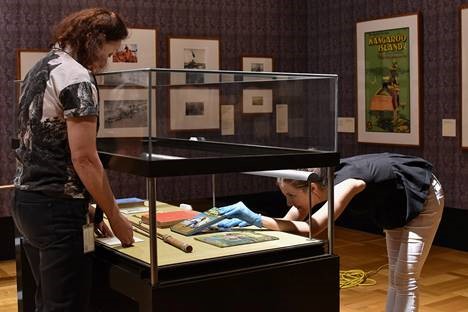
Freya Merrell installing The Catch in our Collections in Focus space
Treatments
Janet McDonald has recently been appointed as Digitisation Conservator for the Treasured Voices digitisation project. Her immediate focus has been working through the papers of Sir John Monash.
Camielle Fitzmaurice and Adele Barbara were tasked with rehousing a 22-metre-long teletype transcript. It is a record of interviews with Holocaust survivors living in Melbourne in the 1980s, containing pre-, during and post-war experiences of Jewish survivors who immigrated to Australia. To enable easy digitisation and access for readers without the scroll unravelling, it was decided that the transcript would be rolled onto two cores, with acid-free buffered paper to support it. These cores were then attached to a base that allows the material to be guided by rolling arms as the document is read from start to finish. The result is a bespoke all-in-one unit that can be used to safely aid digitisation, as well as help researchers read through the entire transcript without physically handling the fragile object.

The custom rehousing for a 22-metre-long teletype transcript.
Late last year we welcomed Jennifer Todd to our team. She, alongside Nick Baylart, has been working towards treating a large quantity of index maps in preparation for digitisation, as well as a broad suite of materials from the archive of cartoonist Les Tanner.
Work to establish the Strategic Preventive Conservation Program in the Library is continuing. This is building and expanding on earlier holistic preventive projects, such as the review of environmental parameters, to provide a fully connected preventive conservation program that remains distributed across the Library but is centrally coordinated and founded in current conservation practice. This will enable the Library to anticipate and plan for the future needs of the national collection, aligned to the changing strategic and operating environment and employing economically sustainable, evidence-based risk management approaches.
The Preservation team has been responding to the bushfire smoke situation in Canberra over the summer. We are monitoring our public and collection spaces for the presence of smoke particles, and look forward to sharing our results with our colleagues in due course.
Professional development
Lisa Jeong-Reuss, Freya Merrell, Sara Freeman and Camielle Fitzmaurice took part in a series of bookbinding workshops following the National Bookbinding Conference ‘Bind 19’, which gave them a chance to finesse their leather paring, sewing and binding skills. They have been sharing knowledge with the rest of the lab, focusing on medieval stationary bindings. With their support, the rest of the team have been honing their skills, working to create their own stationary bindings with parchment covers.
NSW
Art Gallery of NSW
Exhibitions
The Art Gallery of NSW has been preparing works for several upcoming exhibitions in addition to working closely with the Biennale of Sydney in preparation for the 22nd Biennale (2020): NIRIN, which opens at the Gallery and several other venues on 16 March.
Conservation has also been involved in group visits to regional venues in order to support them in hosting some of our upcoming touring shows including: Fieldwork and Brett Whiteley: drawing is everything.
Sarah Bunn and Lily Yang have been preparing works for Under the stars, an exhibition that marks 250 years since Captain Cook landed at Kamay (Botany Bay) by exploring our understanding and relation to the night sky with a focus on Indigenous knowledge.
Analiese Treacy has just completed the preparation of close to 100 photographic works from the collection for inclusion in an upcoming exhibition entitled Shadow catchers, which investigates the way images reflect and refract reality. Sofia Lo Bianco is working on the Biennale and contemporary works for Shadow catchers, while Kerry Head has just completed the conservation treatments for the Yiribana Gallery rehang while also working on loans.
A group of paintings and frames received funding for treatment for the upcoming Streeton retrospective exhibition, Streeton, in September from Conservation Benefactors.
Andrea Nottage undertook a varnish and overpaint removal on a large still-life painting, Lilium auratum, which has revealed the life-sized, bright white flowers and orange stamens against a deep green background. As a result of conservation and curatorial research, the painting has been redated from 1933 to circa 1908. Paula Dredge and Simon Ives have contributed an essay to the exhibition catalogue discussing Streeton’s practice of painting over pre-existing paintings such as a long-lost view of the Gloucester Buckets range that has been identified underneath the painting of the lilies.
Frames Conservation is continuing to treat several works for the Streeton retrospective. Grace Barrand has finished a major treatment of the frame for Chepstow Castle 1902 and started to work on the frame for Melon 1926. Genevieve Tobin continues major treatment of the frame for Gloucester Buckets 1943, which is in the final stages of overpaint removal.
Barbara (Basia) Dabrowa works on treatment of frames for the Australian paintings requested for the extensive loan to the National Library of Australia in October 2020, including the major treatment of the frame for the Frank Mahony painting Rounding up a Straggler 1889.
Staff changes
Paper Conservation bid a farewell to Dominic King who has been working in mount cutting. He leaves us to take up a contract position at the NGV – Dominic was a great asset to the team and will be missed. We welcome back Jonathan Dennis who returns to mount cutting after six months working with the curatorial team researching the work of sculptor Margel Hinder for an upcoming exhibition of her work to open at the Gallery in June, before touring to Heide.
The Paper Conservation team looks forward to welcoming Lois Waters, who will take up a position in mid-February. Lois comes to us from the Grimwade conservation centre and we look forward to having her join the AGNSW team.
Objects Conservation is pleased to welcome William Sit, who has just returned from the US where he was working at the New York Museum of Natural History. William will be backfilling Melanie Barrett’s position while she is working on the conservation of loans for the upcoming Margel Hinder exhibition.
Professional news
Conservation is excited to announce Malgorzata Sawicki has been invited to deliver a course on cleaning of gilded wooden surfaces for master’s degree conservation students at the University of Gothenburg in March 2020.
We congratulate Paula Dredge on her recent Getty publication Sidney Nolan: The Artists Materials. The book celebrates Paula’s technical analysis and original scholarly research into the materials and techniques of one of Australia’s most iconic and complex modernist painters.
Andrea Nottage, Barbara and Paula have been involved in a film project with artist Gabriella Hirst. Gabriella was awarded the Ian Potter Moving Image commission in 2019 for her project entitled Darling Darling, which shows the care and conservation of the WC Piguenit painting Flood on the Darling 1890 and its original frame, alongside images of the river filmed in 2019. The commission will be premiered at the Australian Centre for the Moving Image in May 2020.
Australian Museum
Professional
Sheldon Teare (Natural Sciences Conservator) finished nine months as Acting Manager in early February. Sheldon has determinedly led the team from June 2019 through a mammoth period of change, which included the relocation of the whole Collection Care and Conservation (CC&C) team and pack-down of the lab. Sheldon successfully negotiated: a name change for the unit from Materials Conservation to Collection Care and Conservation; approval for two new positions; budget increases; the smooth but huge task of transitioning out of the old lab; and finalising plans of the new lab configuration. Thanks to the hard work of Sheldon, it is hoped the new lab will have a rejuvenated focus and be a place for new ideas, new collaborations, new people, and new opportunities.
Heather Bleechmore (Objects Conservator) will be Acting Manager from February 2020 until November 2020. Working closely with Sheldon over the last nine months, Heather can now take the reins to ensure the team is relocated back into a new workspace and hits the ground running with the preparation of the reopening of the AM in September. Exciting times!
Robert Clendon, who initially joined the team to fill the role of Natural Science Conservator while Sheldon was acting, now takes on the role of Cultural Collections Conservator, working with the First Nations collections and Pacific collections while Heather is Acting Manager.
Clare Kim joins the team as our Digitisation Conservator for the Collection Enhancement Project (CEP). Clare will eventually work across all of the AM collections to assess and prepare collection items for digital capture. The CEP will initially start with a planning stage and then follow with a target of digitising one million collection items in the first four years. This stage will focus on the Life and Geoscience collections and the Archaeology collection. Welcome to the team, Clare.
Rehan Scharenguivel has recently been appointed Collection Care Conservator in an ongoing role. This is an exciting position for the department, which will see the overhaul of our environmental monitoring, IPM, and materials testing programs. These core business programs have been well established within the unit for many years and are solid platforms from which new ideas and new work approaches already introduced by Rehan can start. Welcome to the team, Rehan.
Exhibitions and Projects
Project Discover
It is an extremely challenging but exciting time as we wait for the new lab to be constructed due to the AM major building redevelopment, Project Discover. The team has been relocated over two floors in another building with limited access to lab space, and major building works to negotiate. Project Discover continues at a rapid pace and is progressing relatively smoothly. It has been keeping the team busy with vibration monitoring and mitigation strategies, gallery maintenance, and calls for assistance. In order to understand the nature of construction methods, Sheldon and Heather have had the opportunity to see demolition techniques in action through ‘hard hat tours’ of the building site that have been an eye-opener to this daunting yet impressive transformation for the AM.
Michael Kelly in December 2019 de-installed Splendid traditions, an in-house exhibition featuring Chinese cultural objects on display in the Panizzi Gallery, University of Wollongong. Michael is also carrying out the processing of a loan from the First Nations collection that was included in the Art Gallery of South Australia’s exhibition Bunha-bunhanga: Aboriginal agriculture in the south-east. Michael also continues to provide advice and prepare library material for a pilot digitisation project.
Megan Dean-Jones has commenced preparing natural science material for a timely new climate change exhibition. The exhibition will focus on the impact of climate change on our environment and will be in place ready for when the Museum reopens later this year. Megan also prepared a shortfin mako shark jaw for a travelling exhibition on sharks, which will visit several Stockland shopping centres across NSW over the next few months.
Robert Clendon has commenced working on preparing First Nations material for the upcoming Unsettled exhibition in the Grand Hall. Unsettled is a First Nations response to the 1778 arrival of British ships on the eastern shore of Australia, and will be in place when the AM reopens.
Australian National Maritime Museum
Professional Treatments
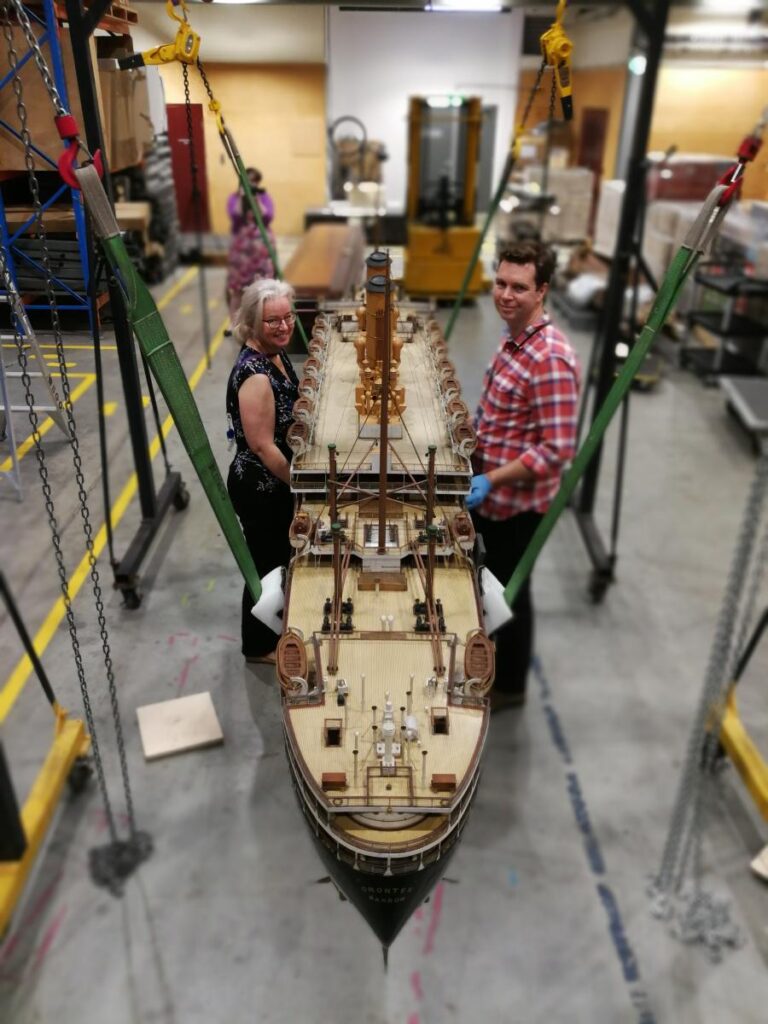
Getting the SS Orontes model onto its new support. Image: Rebecca Dallwitz and Kate Pentecost.

Rigging for lifting. Image: Rebecca Dallwitz and Kate Pentecost.
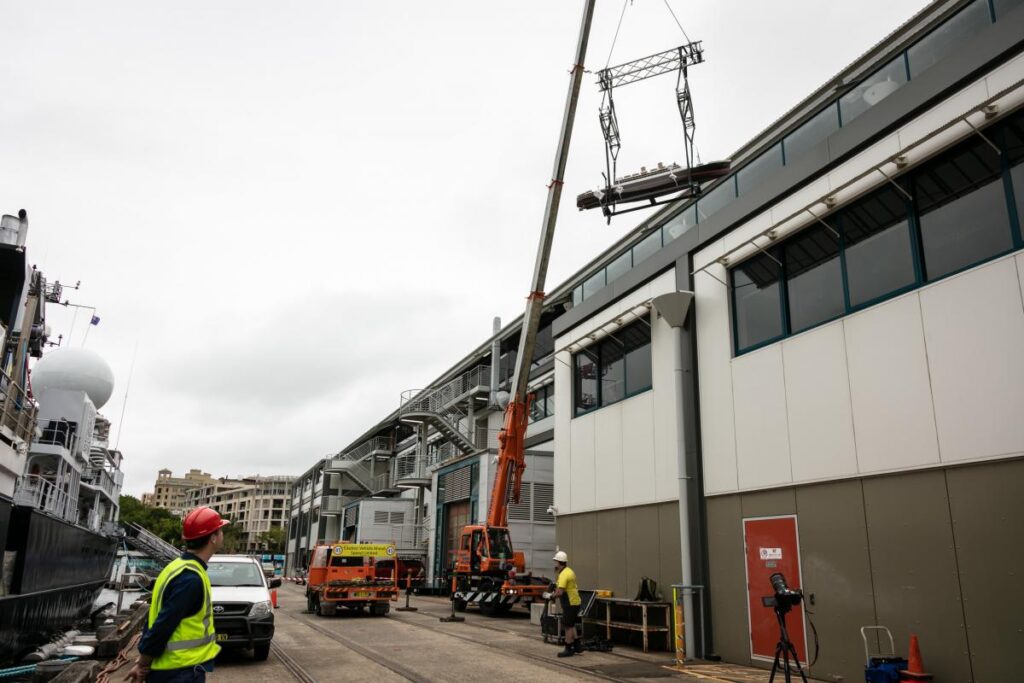
Craning the SS Orontes model. Images: Kate Pentecost and Jeff Fox.
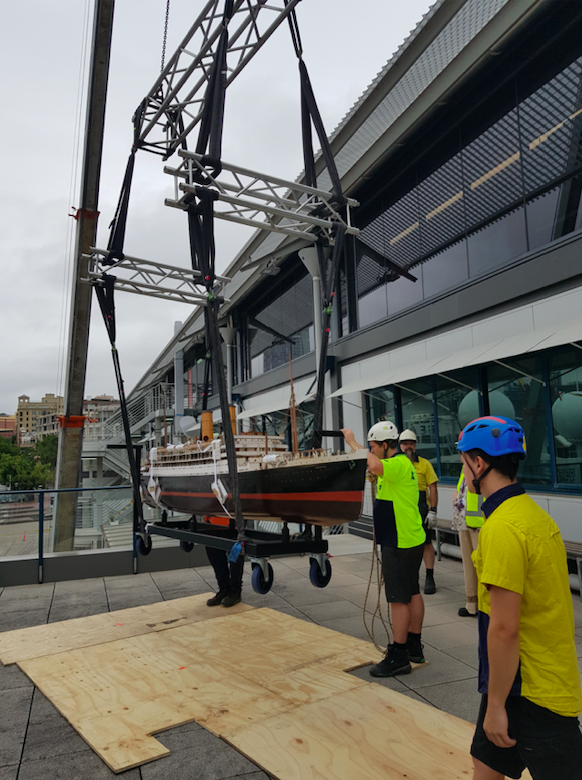
The model landing on Level 2. Images: Kate Pentecost and Jeff Fox.
The Maritime Museum conservation team celebrated the new year by moving the enormous builder’s model of the SS Orontes up to the conservation lab. At almost five metres in length, the model wouldn’t fit into any of our lifts, so, needs must, we craned it up to Level 2.
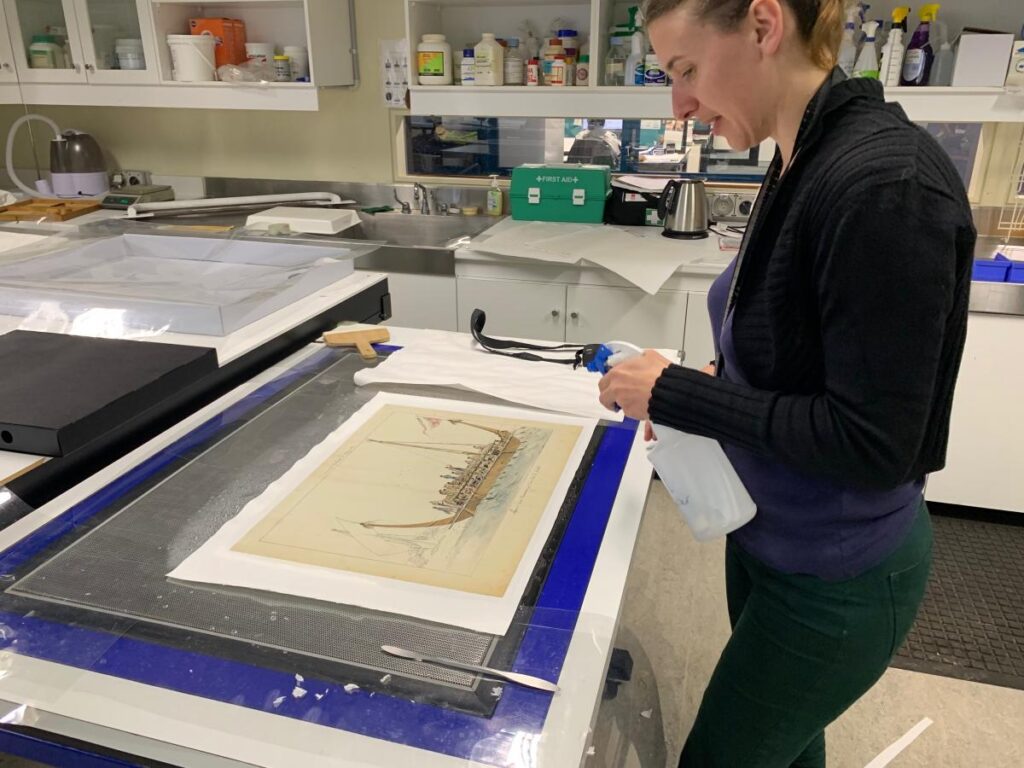
Katie Wood during the treatment of the 19th-century prints and drawings collection. Image: Lucilla Ronai.
Lucilla Ronai and Katie Wood have completed the treatment and digitisation of 14 19th-century prints and drawings. They first removed auction house mounts that hid tape, staining and tears. Depending on the needs of each object, treatment then involved tape removal, washing, repair and remounting.
Exhibition preparation
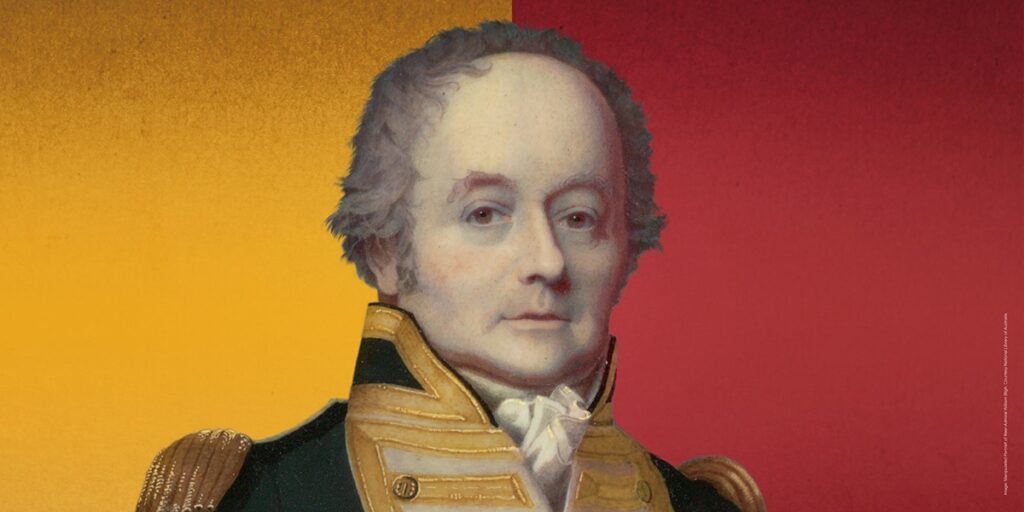
Bligh – Hero or Villain? exhibition promotional banner. Image: ANMM.
The Bligh – Hero or Villain? exhibition was ably demounted by ‘all hands’, including couriers Sara Freeman (NLA), Wendy Richard (SLNSW) and Julia Buckley (Kew Gardens).
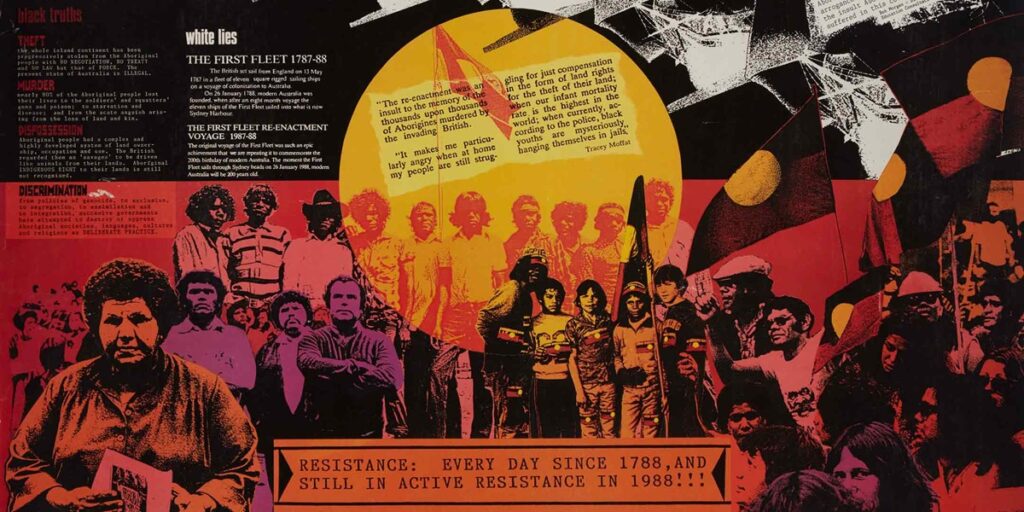
Tall Ships, Tall Stories (J Gemes, E Pelot Kitchener, A Holt, T Moffatt). Australian National Maritime Museum Collection.
To mark the 250th year since Captain James Cook and HMB Endeavour charted the east coast of Australia, the Maritime Museum has developed the Encounters 2020 program. Consisting of a number of events and exhibitions, Encounters 2020 recognises the achievements of Cook’s 1770 scientific voyage and the lasting impact on Australia’s First Peoples and the nation as a whole.
Rebecca Dallwitz and Nick Flood have been preparing for the Looking back looking forward exhibition. It is the land-based side of the commemorative circumnavigation of Australia by the HMB Endeavour replica. Objects will travel around the country by truck, meeting the vessel at each stop along the way.
Workshops, symposia and media
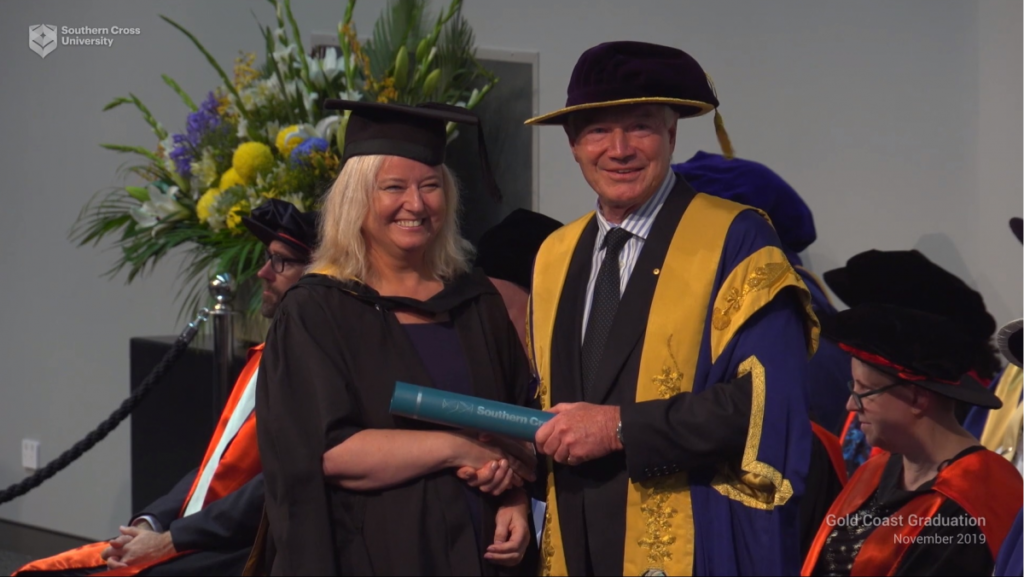
Agata at her graduation ceremony. Image by SCU.
At the end of last year, Agata Rostek-Robak graduated with a Master of Business Administration from Southern Cross University. Congratulations Agata, and when are you starting your PhD?
Social news

Rebecca Dallwitz on ‘come dressed as your object day’. Image: Andrew Frolows.
Rebecca Dallwitz has left the Museum after almost 10 years as an integral part of the conservation team. She moves on to take up a position in sunny Lake Macquarie. Rebecca, good luck, we’ll miss you.
Heights Heritage Conservation
Treatment projects and exhibitions
After months of work – wet cleaning, repairing and devising a new and more practical hanging system – the enormous Mona Hessing tapestry Banner 1971 has been reinstalled in the upgraded Clancy Auditorium at UNSW. Hanging some 24 metres long and 2.5m tall, it is one of the only tapestries in Australia to still hang in the space for which it was originally designed.
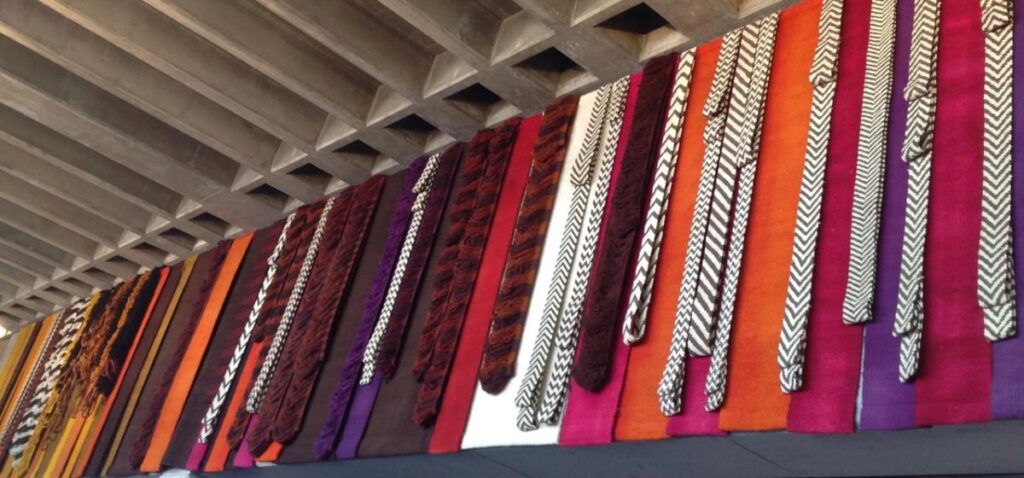
Mona Hessing’s Banner. Image: Tess Evans
When in the UK last year, Tess Evans completed a workshop on traditional mounting of Chinese and Japanese screens and scrolls and has been lucky enough to put it straight into practice.

Scroll, before and after. Images: Tess Evans
Continuing the Chinese theme, Tess has been working on a stunning hand-painted cloth 3m x 2m with extensive water damage and mould. After a rather scary wet cleaning and mould remediation treatment, the painting was mounted onto a new linen backing and prepared for mounting into an acrylic showcase.
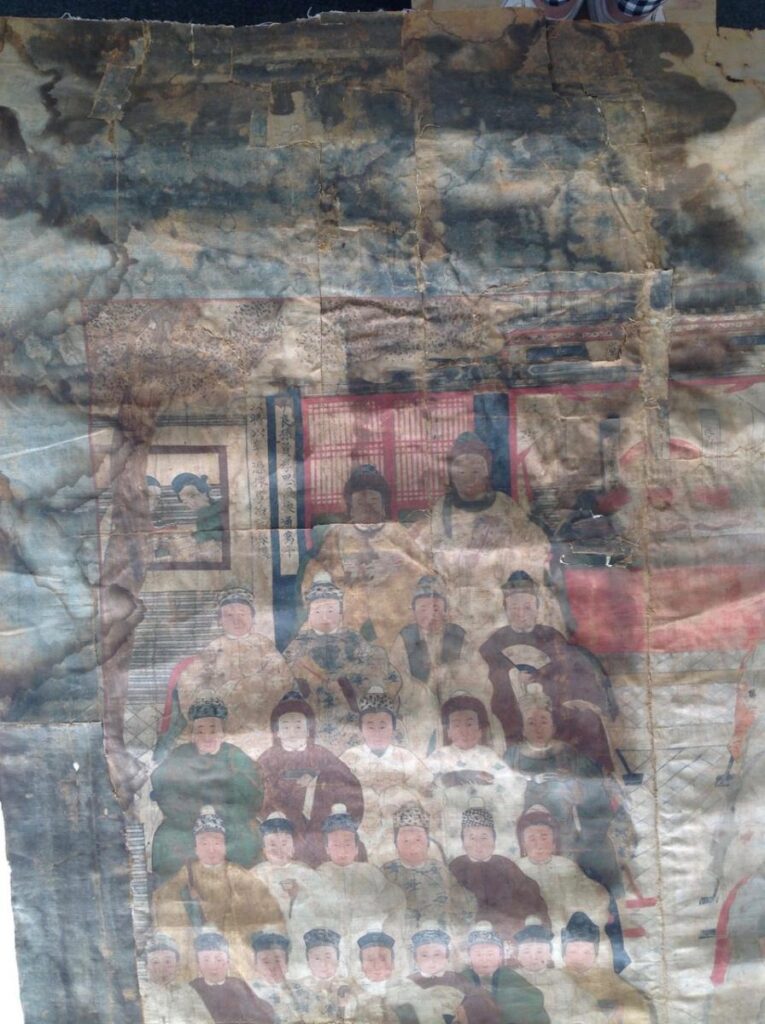
Before Treatment…
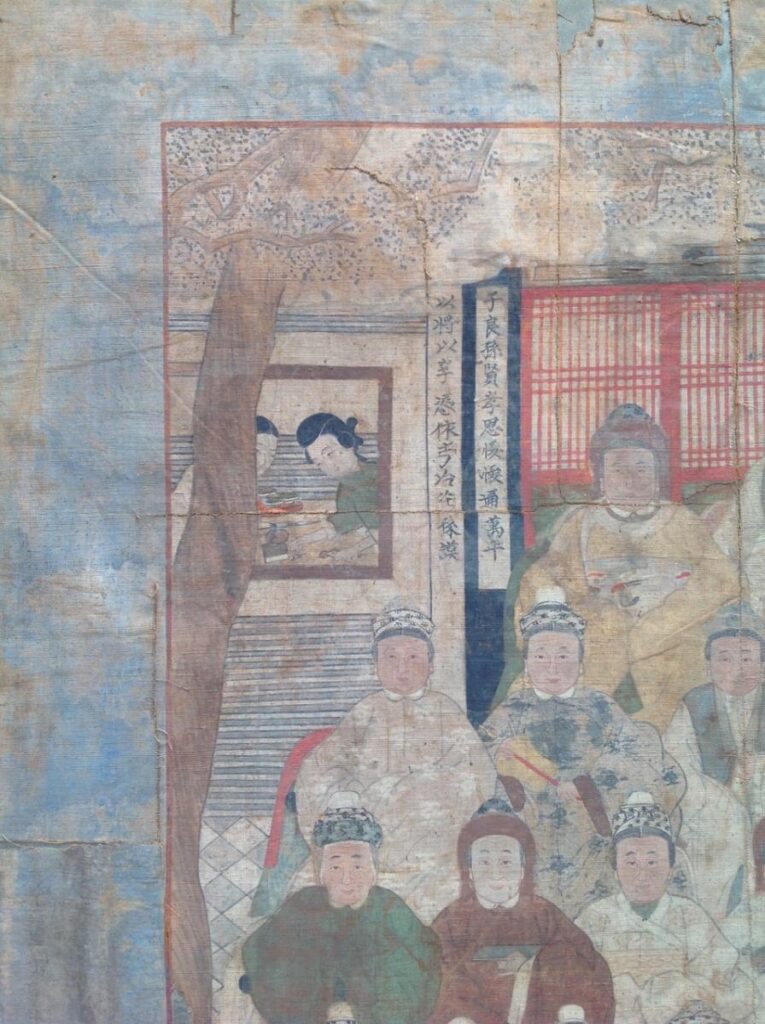
… And after (detail). Images by Tess Evans
Tess has also been working on some lovely privately owned collections including some beautiful 19th-century and early 20th-century folk costumes and a mourning dress, plus a beautiful black silk embroidered fan and a Tibetan thangka.
Tess has also replicated some Jewish stars on loan to Courage to Care, to enable them to exhibit both sensitive and fragile material as part of their education program.
And, most excitingly, we are moving! Tess’s current studio in which she has been working for the last 15 years did appear to be shrinking under a tidal wave of large conservation projects. The solution: a beautiful new studio in Brookvale. After a nail-biting auction, we are really excited to be moving into the huge, bright new space, which will be home to all future projects. Visitors welcome at 8–42/46 Wattle Rd. Brookvale NSW 2010, 0412 398 588.
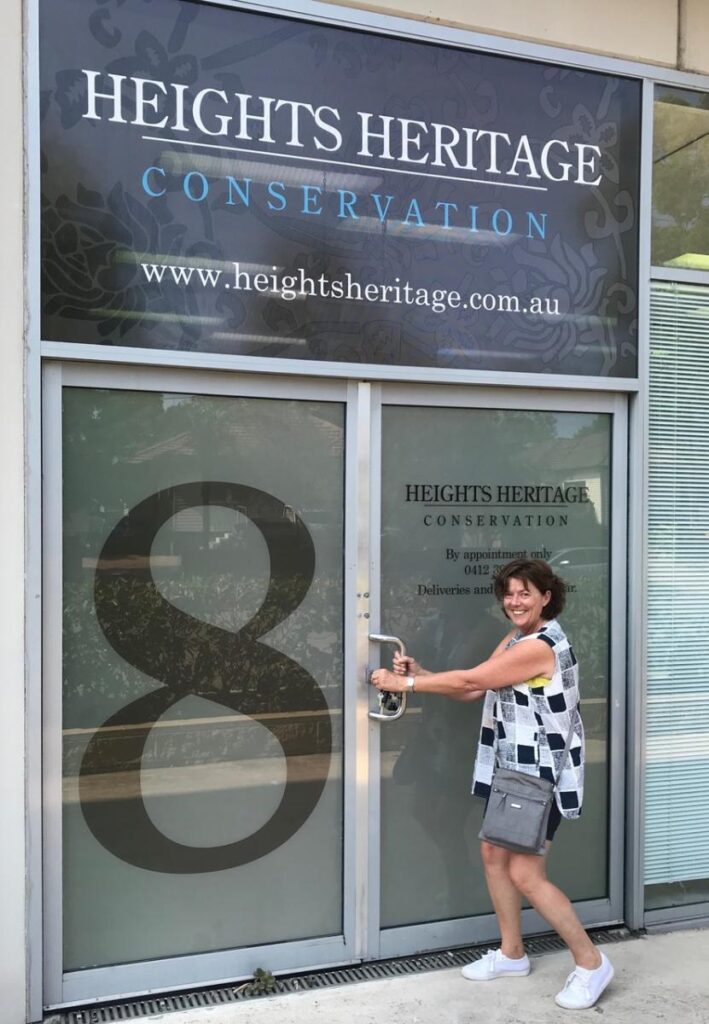
Image: Tess Evans
After obviously doing a good job of designing and making the period costumes for Speak … easy performed at Sydney Fringe Festival last September, Tess has been invited to create for two new productions. The first is Shackleton’s Carpenter, a dramatised reading of the epic story of Harry McNish, starring Peter Fitzsimons, which is being performed at the ANMM 25 February – 1 March. The second is going to be an epic in itself with nine actors playing 22 characters and minimal budget, in the dramatisation of Babette’s Feast, to go up in June. Anyone good on the sewing machine, please call!
Then for a complete change Tess created a special cake for her schnauzer-loving cousin’s 80th birthday.
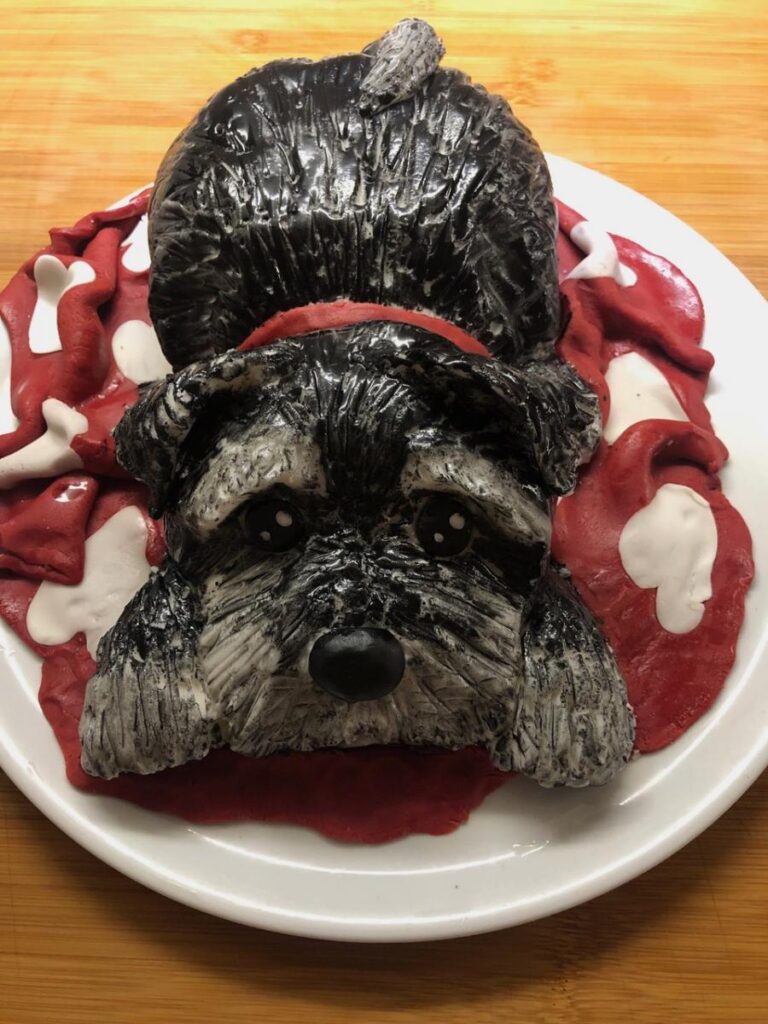
‘Ruby’. Image: Tess Evans
ICS
Paper Conservation
Our paper conservators have been working on a number of water-damaged collections with stain reductions and re-framing. Senior Paper Conservator Wendi Powell undertook treatment on an Albert Namatjira watercolour with great results removing disfiguring discolourations.
Enfield War Memorial
ICS recently concluded conservation work on the Enfield War Memorial, which is surmounted by a WWI Howitzer artillery piece. Led by Rob Williams (Conservation Projects Manager), a team consisting of Sergio Hernandez (Objects Conservator), Amy Walsh (Objects Conservator), and Julian Domenici (Conservation Technician) carried out corrosion treatment, filling of losses, and extensive retouching of the protective paint layer on the gun and repainted the metal flagpole supports. Eden Christian (Graduate Paintings Conservator) joined the project to re-gild the carved lettering on two associated granite plaques.
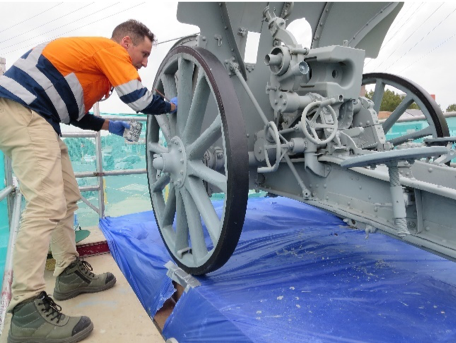
Retouching protective paint layer (Photograph of Conservation Technician Julian Domenici)
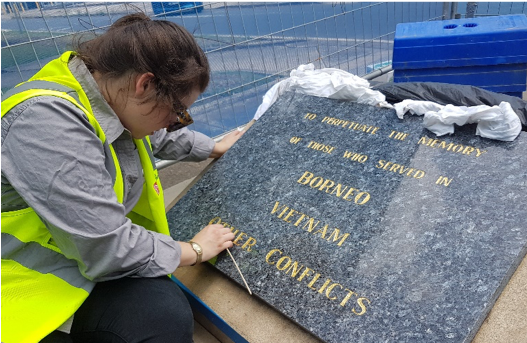
Re-gilding carved lettering (Photograph of Graduate Paintings Conservator Eden Christian)
Museum and Gallery Services
A major undertaking of the last few months has been the assessment of a large collection of heritage machinery equipment currently stored in Campbelltown for the Eveleigh Railway developments. This has entailed assessing the cleaning and conservation requirements for each item of large machinery (each item weighing upwards of 27 tonnes) as well as addressing the hundreds of steel tools. All of this collection information has been moved to eHive, and as we work through the collection it will progressively become publicly available.
Towards the end of 2019, Doug Rogan, Head of Museum and Gallery Services, and Meredith Lynch, Collections Project Manager, managed and undertook the relocation and re-hanging of the Australia Council’s art collection. Meredith has also been working with the industrial heritage collections on Pier 2/3, and the collections of St Andrews College, University of Sydney.
Fiona Tennant, Principal Collections Manager, and Oliver Hull, Furniture Conservator, have been working with Pymble Ladies College on a Preservation Needs Assessment, looking at ways to preserve their heritage collection on display, in storage and in use around the campus. Fiona has also been working with various organisations writing and reviewing Disaster Preparedness and Response Plans.
In the technology sphere, Doug has been working closely with Parliament House in Canberra to install the latest iteration of the Smarttrack RFID tracking solution for their collections, whilst also implementing the Fortecho RFID Art Security solution at the National Gallery of Australia for the recent Monet exhibition and the current Matisse & Picasso exhibition.
The Dying Gaul
Sergio Hernandez (Objects Conservator) and Katie Wood (Paper Conservator) completed treatment on a concrete cast of The Dying Gaul, which had sustained damage to the neck. After reattaching the head and filling areas of loss, the team cleaned the sculpture of biological growth and applied a protective lime wash.
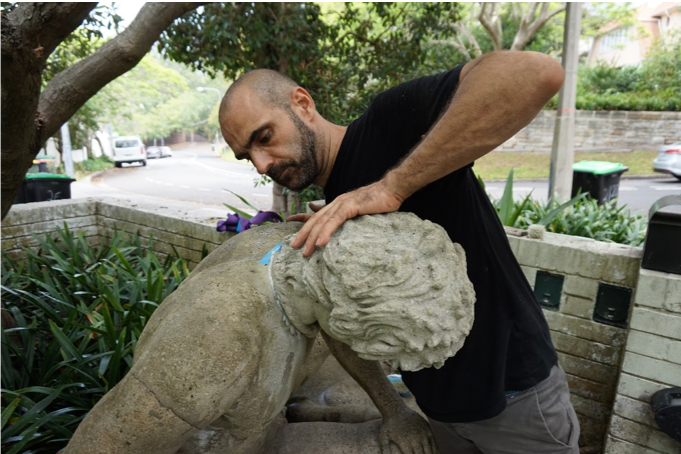
Reattaching the head (Photograph of Objects Conservator Sergio Hernandez, supplied by ICS 12/02/2020)
Paintings Conservation
The Paintings team has been busy assisting with disaster recovery after fires and floods. This included condition assessment of multimedia collections and recovery treatment of artworks.
Paintings Conservator Julia Vandenburg has worked on the removal of a contemporary varnish from a lovely Renoir painting on canvas.
Paintings Conservator Suati Rojas, Conservation Technician Jochen Letsch and Senior Paintings Conservator Matteo Volonte worked on the cleaning, consolidation and restoration of a mural, Trompe-l’œil reproduction of the original 1927 façade of the Wollongong Town Hall, after a purposely lit fire damaged part of the paintwork. The mural was painted by Nick Brash and Peter Day with the collaboration of other artists to commemorate Heritage Week in 1995. The team was fortunate to be able to work in collaboration with Peter Day during the project.
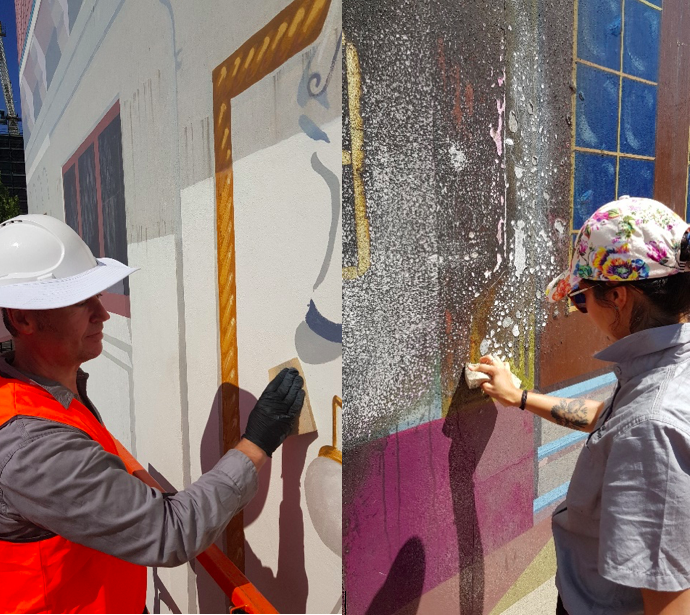
Conservation Technician Jochen Letsch and Paintings Conservator Suati Rojas (Photo supplied by ICS 12/02/2020)
Staff members
Rehan Scharenguivel, Objects Conservator in the Outdoor Heritage and Objects team, and Jennifer Todd, Graduate Paper Conservator in the Fine and Decorative Arts team, have sadly moved on from ICS to join respectively the Australian Museum and the National Library. We wish them all the best with their future endeavours, and look forward to keeping in touch.
We welcome Amy Walsh, who has joined ICS as an Objects Conservator in the Outdoor Heritage and Objects team. Amy graduated in 2016, and recently spent a year at West Dean College in the UK studying ceramics conservation. She has previously worked in a number of institutions both in Australia (NGV, CCMC, State Library of NSW) and the UK (University of Birmingham, British Museum, Royal Collection Trust), as well as on a number of archaeological sites in Italy and Greece.
Museum of Applied Arts and Sciences
Lab news
Trish Stokes continues as Acting Head of Collections & Major Projects, with Kate Chidlow Acting as Conservation Manager.
The Collection Relocation and Digitisation Project assessment team has been joined by assistant conservators Beate Yule, Margot Murray, Wajeeda Tabassum and Freya Gabbutt. Since the project commenced earlier this year, the team has assessed more than 110,000 objects and undertaken over 1,600 minor treatments. We say goodbye to Assistant Conservator Irene Finkelde who has been offered a role at the Australian Museum.
The CRD conservation phase has commenced. Suzanne Chee, Elizabeth Reed, Chris Redman and Rebecca Main are reviewing recommendations made by the assessment team, undertaking treatment and custom re-housing when required.
The CRD hazards management phase has also commenced. Sue Gatenby and Brooke Randall are developing protocol for managing hazardous materials in the collection. This includes packing, storing and labelling hazardous materials in accordance to state and federal legislation, undertaking analysis and treatment when required and identifying items that may be put forward for possible disposal or deaccessioning if the hazard risk is considered unable to be managed safely.
Lili Wang, our new laboratory technician, has been reorganising the chemicals and other conservation materials into chemical cabinets and hazardous materials storage units as well as developing the regulations and requirements for managing the transporting of hazardous materials.
Exhibitions
Kate Chidlow, Frances Fitzpatrick and Teresa Werstak are preparing collection items to be displayed as part of the 22nd Biennale of Sydney. Incorporating and disorganising objects, artists Ramin Haerizadeh, Rokni Haerizadeh and Hesam Rahmanian make a sweeping arc across themes of grief, the body and healing. The installation will open mid-March.
State Library of NSW
Professional
After a busy and successful 18 months, Vanessa Pitt is leaving the Library team on 28 February to return to MAAS. She treated items for the Collectors Gallery display of over 2,000 items. This has included extensive treatment of the Library’s plaster maquette and printing plate collections. She has also planned the movement of heavy and inaccessible collections including marble busts, stone plinths, keystones and a press.

Mitchell Library, State Library of New South Wales, Vanessa Pitt cleaning the back of a gypsum cast of James Cook, ca.1940, manufactured by Wunderlich Ltd., from sculpture by Arthur Fleischmann,R 617. During treatment, back. Image: Zoe Burrell.
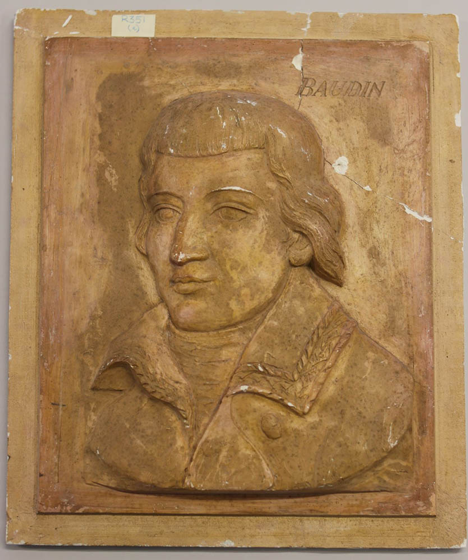
Mitchell Library, State Library of New South Wales, Plaster and gypsum cast of Nicolas Baudin for bronze entrance door of the Mitchell Library, ca.1940, manufactured by Wunderlich Ltd., from sculpture by Arthur Fleischmann, R 351/Item e. Before treatment, front. Image: Vanessa Pitt.

Mitchell Library, State Library of New South Wales, Plaster and gypsum cast of Nicolas Baudin for bronze entrance door of the Mitchell Library, ca.1940 / manufactured byWunderlich Ltd., from sculpture by Arthur Fleischmann,R 351/Item e. After treatment, front. Image: Russell Perkin.
Treatment projects
The conservation treatment of the Corner Journal has reached a significant milestone—the intensive washing treatment of the last pages was completed recently, prior to the commencement of the page repairs. This is a significant achievement for the conservation team: Kate Hughes, Cecilia Harvey, Steven Bell, Wendy Richards, Nichola Parshall and Ruth Drayson.
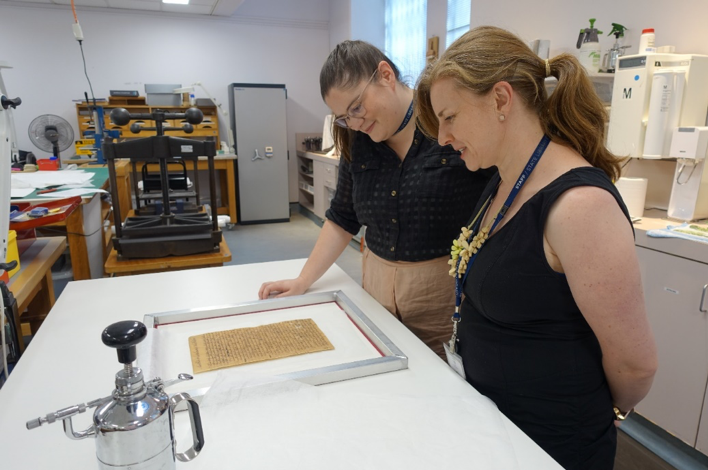
Kate Hughes and Cecilia Harvey observing the last page of the Corner Journal before an immersion wash. Image: Nichola Parshall.
Keyeele Lawler-Dormer and Hoa Huynh from the Digital Excellence Program (DEP) team have been preparing two volumes documenting Aboriginal carvings surrounding Port Jackson and Broken Bay in 1893–1896. These volumes contain sketches of petroglyphs that William Dugald Campbell surveyed across Sydney, and corresponding maps on linen showing the locations of the petroglyphs. The large size of the bound volumes and guard binding has caused considerable damage to the individual leaves, necessitating dis-binding and individual remedial treatment prior to digitisation.
Also in DEP, Natalie Rose Cassaniti has been treating and rehousing the Library’s gramophone records in preparation for digitisation. Initially, 50 records consisting of lacquer, vinyl and shellac dating as early as the 1920s will be prepared for a pilot digitisation. We have acquired a high-end record cleaner to carefully clean the grooves of the records before the records are rehoused in polypropylene sleeves and their covers in archival paper folders.
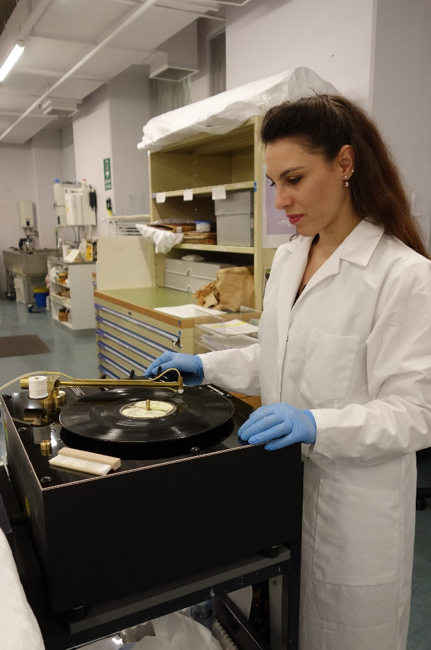
Natalie Rose Cassaniti cleaning a sample non-collection item on our Loricraft PRC4 professional record cleaning machine. Image: Hoa Huynh.
Events
The State Library of NSW hosted the Australasian Rare Book Summer School from 3 to 7 February. It was a busy week for Collection Care, conducting lab tours for participants and setting up many items for the School’s workshop including the identification of English bookbindings from 1450 to 1850, rare book cataloguing, history of maps, and illustration processes from 1800 to 1900.
South Australia
Artlab Australia
Ian Miles has been recently working on the retention and relocation of an historic floor mosaic in Port Adelaide, South Australia. The General Motors Birkenhead facility in Port Adelaide was an assembly plant for numerous makes of vehicles from the mid-1920s. An alliance was formed with Holden in 1931 and an art deco mosaic featuring the GM-H logo was added to the front foyer of the then thriving plant. Following closure of the plant, it fell into disrepair, and the building was later demolished in 1991; however, the mosaic remained.
Having been originally designed and constructed for an internal covered environment, the mosaic had suffered rapid deterioration as it was left exposed to a harsh outdoor environment. Artlab was approached by Renewal SA with an interest to conserve the mosaic (see Image 1, taken from an article in the Adelaide Advertiser, using drone imagery by Renewal SA).

Image 1
The mosaic was condition checked and documented, and a proposal agreed to remove and safely relocate the centre part of the foyer floor containing the iconic GM-H motif. The identified part was 2.4 x 1.9m with the mosaic set on screed and concrete 130–150mm thick.
Removal involved cutting around the identified part with a road saw (see Image 2). The concrete parts were excavated to reveal the sides and underside of the mosaic slab. Surface protection was added to the face of the mosaic and steel beams were bolt-fixed to its sides, top and underside. The steel beams effectively sandwiched the slab to prevent any deflection during movement. The slab was then lifted using a Franna crane truck, with shackles, slings and spreader bar (see Images 3 and 4). It was placed onto a tray truck and moved to its storage location. Excavated foyer slab parts and any loose tiles were removed, packed together and stored for possible future use.

Image 2
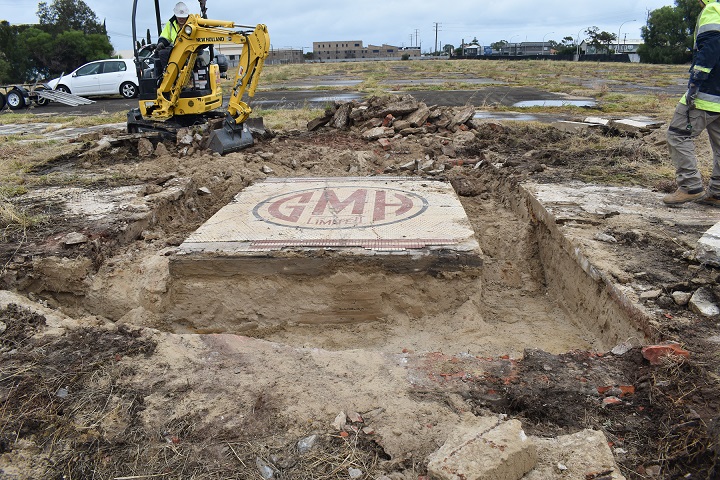
Image 3

Image 4
The end of 2019 saw the Textiles team of Kristin Phillips and Mary-Anne Gooden busily preparing items for the rehang of Morris & Co at the Art Gallery of South Australia. It was lovely to get amongst some iconic Morris textiles and re-acquaint ourselves with some old favourites as well as prepare new acquisitions.
We are delighted to welcome intern Vanessa Liew to the lab. Vanessa is with us for two months from the Heritage Conservation Centre in Singapore. We look forward to working with her to prepare items for Samuari, an upcoming exhibition at the Art Gallery of South Australia.
Tasmania
Applied Conservation Science Pty Ltd, Launceston
David Thurrowgood—I am writing to give a long-requested submission on my new-ish enterprise in the private conservation field. Based out of Launceston, Tasmania, it is an attempt to both provide a different type of conservation service to Tasmania and further afield, and to provide a panacea to many of the complexities of undertaking research and lateral projects within government institutions – some things are very hard to do inside the box.
At a personal level, my thinking has changed significantly in the past four years about what it means to practise conservation as a professional. In part, this is due to the experience of media-monitored audiences measured in the hundreds of millions that feature the word conservation (without referring to trees). But more important was an experience of giving an invited lecture at a Gordon Research Conference where the best minds in conservation and surrounding, genuinely interested, fields were present to deconstruct and reconstruct—in an entirely good-willed manner—what it is that we collectively think we are doing. Free from the structure and dynamics of ‘small pond’, different understandings germinate.
In part, this has manifested itself as Applied Conservation Science Pty Ltd, which now owns a 240-square-metre laboratory and meeting-of-minds space in Launceston, the far end of the world. The space is steadily under development and includes the usual strong room, security and climate control, improving as funds permit. A Sigma-Aldrich account, some large stainless-steel benches, digital microscopes, a small workshop, and the facility is well on its way. In the near future, the space will hopefully feature a small onsite accommodation facility for visiting students and colleagues. My business model is based around having a space where things can be made to happen, with projects ebbing and flowing. If you have an idea, please email enquiries@appliedconservationscience.com.au
In the words of Tom Waits: What is he doing in there? Current projects and collaborations are:
- Artificial intelligence-based deconstruction and analysis of artworks using a model Vincent van Gogh oil painting in collaboration with an American institution.
- Local development of an advanced design and construction of oxygen-free cases for long-term display, which include custom electronics and lighting systems that will reduce the quantum yield and chemistry of artwork change.
- Design and construction of prototype ‘conservator-designed’ display lights and control system, including a just-in-time manufacturing pathway to reduce cost.
- Technical assessment of artworks signed Rodin, Vincent, Monet, Tom Roberts and Glover.
- Development of a database of THz infrared spectra collected on a synchrotron beamline to provide a novel spectral fingerprinting method for late 19th-century artist pigments.
- Exploration of a new methodology for synchrotron x-ray tomography, cross-section study, and Pb210 isotope decay in assessing bronze sculptures.
- The securing of a second substantially intact sequence of thylacine DNA, and creation of the first systematic description of thylacine hair from different parts of the pelt.
- Development of a new method for Tasmanian traditional shell-necklace cultural practitioners to clean shells without acid, and study of the structure of shell surface to preserve iridescence.
- And, yes, we clean silver too! Conservation treatments are a big part of the business.
An example of our work:
Tasmanian shell stringing is an increasingly recognised art form and continuing cultural practice. It comes with many questions, including around the traditional versus current making technique, and its impact on preservation.
Extremely sensitive synchrotron analysis does not show coloured molecules within the shell matrix.
Supported by SEM study and laser microscopy, the colour of the surface appears to be a function of a diffraction grating in the calcium carbonate that is a complex function of shell growth, and varies between species. This structure is fragile.
These surfaces may be relatively light fast but are extremely sensitive to environmental pollutants such as acid off-gassing from materials like MDF, which appear to be extremely damaging under SEM observation. Fading appears to be not related to photon exposure, but chemical and physical destruction of the diffraction grating/microprism that is causing the surface colour.
Admittedly based on a limited sample size, there is no current observation supporting the hypothesis that shells are being weakened by climate change. Historic and modern shells appear structurally and chemically similar. Further work is required to confirm this. Observed more rapid deterioration and weakness in the shells is probably the product of contemporary preparation methods. This does not mean that ocean acidification will not be a future issue, and is not contributing to the increased rarity of the source shells.
Preliminary experiments indicate that a component of modern cosmetics may be an effective method to strip the coating from shells and be a substitute for hydrochloric acid. Strong acids tend to cause significant fragility to the shell microstructure and act as a pathway to rapid deterioration.
There is some evidence that very early surviving necklaces had the shells packed with ash (and possibly ochre) and a binding medium as a deliberate activity, with a possible resin cap at the shell opening. This appears to strengthen the shell, cause a different visual impact, and would have chemical impacts on the shell due to the properties of the ash.

Laser microscopy rendering of a shell surface used in necklace-making (modern)

Shell surface, visible light microscopy
Victoria
ICS Melbourne
People
ICS Melbourne continues to expand, with the welcome return of Fran Paterson from maternity leave. Fran had been working out of the Sydney office prior to taking maternity leave and now takes on the role of Senior Conservation Manager at the Melbourne office in Abbotsford. Meanwhile Kristine Allinson and Bruno Bell have been deep in the treatment of one major archaeological collection from a city site and are about to immerse themselves in another, the Metro north site in Latrobe Street, where Kristine worked as the site conservator over many months in 2019. Kristine and Bruno have also been treating various interesting objects for ACMI for their re-opening exhibition.
Alex Morris joined ICS in January as our Conservation Technician in Melbourne. Alex has previously been employed as a Winery Laboratory Technician with NSW wineries between 2010 and 2014. Before that, he worked as a seasonal farmhand on his family’s property for three years. Since 2014 he has worked as the E-Commerce Customer Service Representative and Stock Manager for an online fabric distributor in Melbourne.
National Gallery of Victoria
General news
Head of Conservation Michael Varcoe-Cocks and Coordinating Conservator MaryJo Lelyveld have been liaising closely with Assets and Facilities to mitigate the worst effects of extreme weather conditions over the summer period to ensure we meet loan agreement conditions.
The department has provided a range of outreach and in-house training programs – including ‘Basic Art Handling’ for curators and registrars who are relatively recent arrivals to the NGV and ‘Collections Disaster Preparedness and Response’ training for registration and ECO staff – and supported a range of tours for NGV work-experience students and NGV supporters. MaryJo is also coordinating conservation input towards the broader We Change the World and NGV Triennial exhibitions.
Michael travelled to Los Angeles on courier duties and met with Getty Conservation Institute colleagues. In February he also commenced a research project at the Australian Synchrotron.
Check out @ngvmelbourne Instagram for rolling Conservation department updates, including previous stories archived under the ‘Conservation’ highlights, and an IGTV video covering some conservation considerations with the seven-metre-tall KAWS Gone sculpture currently on display in the NGVI Federation Court.
Michael also recently completed a treatment on a new acquisition and spoke about the artwork on Radio National (Link: https://www.abc.net.au/radionational/programs/the-art-show/collection-selection:-the-paper-boy/11928166 )
The department concluded 2019 with a celebration, which included a bake-off and ping-pong.
Textiles
Prepping a 400kg textiles artwork for the upcoming We Change the World show, and Japanese modernism prep, has occupied Skye Firth, Ellen Doyle, Di Knight and Kate Douglas. The studio is also nearing completion of the Balenciaga Infanata dress treatment, which will be featured online, and a major treatment of the first of two Murdoch curtains is continuing. They are also undertaking fabric research for replica garments to accompany 18th-century new acquisitions. At the start of February, Kate commenced her long service leave—first stop New Zealand.
Paintings
In the paintings conservation studio several long-term projects are well under way or nearing completion. A year-long project of digitisation of the NGV’s painting conservation records is now in its late stages. While we continue to add to our hard-copy dossiers, we are already seeing huge benefits by having our complete treatment records available in digital format, not least in being able to compile a comprehensive history of over a thousand treatments performed at the Gallery since 1869, and every conservator who is recorded to have worked with the NGV since then.
Another project that is well under way is the major condition survey of the Gallery’s Indigenous bark paintings. This has been carried out by Raymonda Rajkowski with the assistance of University of Melbourne graduate Murphy Bouma. Caitlin Breare continues work on detailed examinations of British paintings in the NGV collection as part of the ongoing British Catalogue online project. Caitlin’s recent focus has been on the Gallery’s significant collection of paintings by John Constable. Carl Villis has been carrying out solubility tests on artificially aged samples of the new MS3 varnish that has been developed by CSIRO with assistance from the NGV. The solubility test results will be published as part of a comprehensive analysis on MS3 varnish resin, co-authored by Deborah Lau from CSIRO.
Raye Collins and Raymonda, who have recently taken up the convenorship of the AICCM Paintings SIG, have been laying the groundwork for a major symposium to be held in Melbourne.
Raye has commenced work on several new acquisitions – portraits by Dora Maar and Constance Stokes – and has been liaising with the Melbourne artist Asher Bilu for him to carry out some repair work on one of his panels from the 1960s, which recently entered the collection.
Carl has completed work on another new acquisition, Lady in white by British painter Annie Swynnerton, and has commenced work on another new arrival, a small portrait by the 17th-century British painter Mary Beale of her young son, Bartholomew. At the same time, he has also begun varnish removal on a 19th-century British seascape by painter Henry Moore.
Caitlin continues the inpainting on her major treatment of Thomas Clark’s The Upper Falls on the Wannon, whilst Raymonda has recently completed a large consolidation treatment on Summer landscape by Edward Middleditch and a series of smaller treatments on Indigenous paintings in the collection.
Frames and Furniture
Holly McGowan-Jackson and Suzi Shaw are working on new acquisitions, including a Danish chair and four coffee tables. The Centre for Frame Research has completed two new frames: for Camille Pissarro’s Boulevard Montmartre, morning, cloudy weather and Fred Williams’ Dark hillside, both now on display. Jason King and contractor Rob Murdoch have also started the frame for a well-known Australian Impressionist painting after extensive research has been undertaken. Holly wrote a short piece for NGV Magazine on the Pissarro reframing and Suzi contributed a piece on a Shaker rocking chair.
In February 2020, a major frame restoration project commenced. The Centre for Frame Research project will be undertaken with assistance from recent graduates Bella Lipson-Smith and Dominic King, working part-time over three months. The treatment, due to be completed by September, will enable the large 1871 original Melbourne Stevens frame to return to the painting Departure of the Pilgrim Fathers by Charles Cope for eventual display in the Salon Room.
Suzi assisted with the Bamboo exhibition install at NGVA, as well as ongoing preparation of new acquisitions and assisting with display changeovers.
Holly and Jess researched and co-wrote an article on Australian frame-maker Lillie Williamson for the next NGV Magazine issue.
Exhibitions
Exhibitions and Loans conservators Catherine Earley and Janelle Borig have been reviewing works for condition and exhibition needs for Top Arts 2020 and reviewing loan agreements and budget and display requirements for works to be included in Camille Henrot: Play your part, Destiny and MWM 2020: Pierre Bonnard.
Paper and Photography
Ruth Shervington, Louise Wilson and Pip Morrison have been engaged with preparing around 100 works for the upcoming Japanese modernism show, as well as continuing to increase their case files numbers, and undertaking historic treatments on sick bay works.
Louise recently completed courier duties for the William Blake show that was held in London.
Objects
The Objects studio has also been involved with the Japanese modernism show as well as continual new acquisitions and works going on loan. Marika Strohschnieder completed a treatment on Shrine, a previously undisplayed polychrome wood sculpture, and wrote a short piece about the treatment in the upcoming NGV Magazine. Trude Ellingsen has been continuing material testing, and growing crystals for the conservation of a crystal-based contemporary artwork. The outdoor sculpture program, as well as maintenance of KAWS Gone, has kept Di Whittle occupied and she is nearing completion of the treatment of David Wire’s Abstract construction.

Assistant Conservators Bella Lipson-Smith and Dominic King commencing the Cope frame treatment.

On the left Louise Wilson, Conservator of Paper, and on the right Ruth Shervington, Senior Conservator of Paper and Photography, are enjoying the Conservation department end of year celebration.
State Library Victoria
Preservation & Conservation Social Comings and goings of staff
Jean Holland, our Senior Book Conservator, has announced her retirement after 30 years at the Library. We will miss her wry sense of humour and especially the role of mentor that she played to so many conservators and colleagues over the years. We wish Jean all the very best for her next adventure.
Tristan Congreve finished up as a volunteer with the Preservation team at the end of 2019 to move to Sydney.
Josh Cassidy has become a part-time ongoing Preservation Technician.
Jess McElhinney has accepted a part-time ongoing position as Paper Conservator.
Events
In October, as part of the Library’s Vision 2020 Redevelopment, we contributed to the opening of the inaugural exhibition Velvet, Iron, Ashes in Victoria Gallery. In this 500-square-metre grand heritage space, our visitors can learn about the unexpected links between some of the state’s most influential people like Janet Lady Clark, events and icons including Ned Kelly, the Ashes Urn, MacRobertson’s Freddo Frog, Yallourn Power Station, Jessie Clarke and the Nappy Wash service.

Assisting with the photography of the Jessie Clarke costume. Credit: SLV Photography.
The long-awaited Library redevelopment came to an end in December, with the opening of the Swanston Street Foyer, the newly refurbished ground floor of the Dome, a dedicated children’s area, a new conference centre, public meeting rooms and sound studios. The Westlink Staircase and the Queens Hall, which have been closed for over 15 years, are now open to the public. The 1920s murals by Septimus Power and Napier Waller that line the staircase were treated by Artcare during the redevelopment, and The Ian Potter Queens Hall with its newly restored glass ceiling is now home to the Australian Literature Collection. Come in and have a look.
Professional Treatment projects
Preparation for the Velvet, Iron, Ashes exhibition included a range of interesting conservation challenges, in particular the display of a 12-metre-long textile artwork in a curved freestanding structure. Coranderrk, yalingbuth yalingbu yirramboi – yesterday, today and tomorrow (H2019.278) consists of calico panels stitched together, printed with digital images and text, basketry samples and needlework, which relate to life at the Coranderrk Aboriginal Station, Healesville, Victoria (1863–1924). To display the artwork safely, our paper conservators reached out to conservation colleagues and pored over Gwen Spicer’s new publication Magnetic Mounting Systems for Museums and Cultural Institutions. The successful display uses a two-part magnet-to-ferromagnetic-material system. This comprises rare earth magnets spaced along the upper edge and sides, holding the textile to pre-drilled galvanised steel strapping screwed onto the curved wall. Tyvek tape was used as a barrier layer at the magnet/textile and textile/strapping interfaces. To make the magnets less conspicuous, each is covered with a digital print of the calico textile (printed onto archival paper, backed with Jac paper and cut into discs using a hand-punch).
The book conservators have been constructing models of traditional 19th-century extra-letterpress leather bindings to hone their skills in leather paring and traditional hand techniques. This was good preparation for the repair of a 17th-century leather English binding, which had split through the leather tight back spine, requiring a leather underback, expertly undertaken by Ian Cox and Katrina Ben, with paper repairs by Alby Hamilton.
Preservation projects
Highlights from the Preservation team include completion of the Records of the Sheriff’s Office Victoria archive (YMS 14521) rehousing project, which involved over 10 years of untying, unfolding, flattening, cleaning and rehousing thousands of parcels tied up with string. The archive, now comprising 300 boxes, contains warrants dating from 1838 to 1949, which outline proceedings brought against Victorians who had not paid government fines or fees or repaid debts. Work also continues on a number of other large collections, including the Bruce Postle photographic archives, Robin Boyd business archives, ABC vinyl records, Vali Myers realia, Stephen Murray Smith papers, and the archive of Norman Banks, who established Carols by Candlelight in Victoria.

Photograph from the archive of Norman Banks (YMS 16274). Credit: SLV.
Exhibitions and loans
Late last year, Conservation and Registration organised the dispatch of photography books to the Ballarat International Foto Biennale and the loan of the 1835 colonial manuscript, the John Helder Wedge Field Book, to the Art Gallery of South Australia as part of the Bunha-bunhanga exhibition. Registration has also managed 70 incoming loans from 10 lenders as part of the Velvet, Iron, Ashes exhibition, which included a range of public and private collections and everything from lumps of coal, cumbersome washing machines and the Ashes Urn from Lords Cricket Ground. The touring exhibition Self-made: Zines and Artists Books has returned from its final venue, Latrobe Regional Gallery, after travelling to several regional venues across Australia over the last two years.
In November, the book conservation team completed the annual changeover of more than 300 book-related items over five days in the permanent exhibition World of the Book. New collection items include the Second Folio of William Shakespeare’s plays, published in 1632, and countercultural classics from the New Journalism group of American writers. For the exhibition, a rare French natural history book from the Castelnau Collection was reunited with a 19th-century specimen drawer of beetles collected by the Count of Castelnau, on loan from Museum Victoria.
Work is well under way on the Changing face of Victoria exhibition changeover, scheduled for March 2020. This will include a full changeover of existing material, with more than 150 new objects and exhibition reproductions, 90 per cent of which have never been exhibited before, covering themes of water, camping, coffee and workers’ rights. The new display will include the oil painting Yarra Bank Meeting 1923 by Patrick Harford, a modernist-style painting depicting a trade union meeting on the banks of the Yarra River. Conservation has deframed and examined the painting following research on the artist, a member of the Victorian Artists Society and union activist. Treatment will include surface cleaning and re-stretching over a new larger stretcher to reinstate the previously masked edges. To complete the treatment, the painting will receive a custom period-style frame. The exhibition will also showcase some new approaches to object display at the Library, including a range of custom angled supports made in Conservation to elevate flat works for easier viewing.
Conference/Training attendance
Last year was a good year for professional development opportunities.
Helen McPherson attended the Australian National Bookbinders Conference hosted by the NSW Guild of Craft Bookbinders, 25–27 October.
Katrina Ben participated in a 5-day Victorian account book (or spring back) binding workshop conducted by Dominic Reilly in Sydney in October.
In June, Katy Glen attended the 7-day workshop ‘Recent Advances in Characterizing and Preserving Photographs’ Spring School in Paris.
In June, Jess McElhinney travelled to Berlin to attend the 2-day seminar ‘Conservation of Tracing Paper’ with Hildegard Homburger.
Leah Williams attended the Getty Conservation Institute’s ‘Preserving Collections in the Age of Sustainability’ 2-week intensive course in October, hosted by the National Gallery of Victoria.
Jane Hinwood, Albertine Hamilton, Jessica McElhinney, Leah Williams, Emily Keppel, Joshua Cassidy and Jessye Wdowin-McGregor attended the AICCM National Conference 2019 at the Arts Centre, Melbourne, 13–15 November.